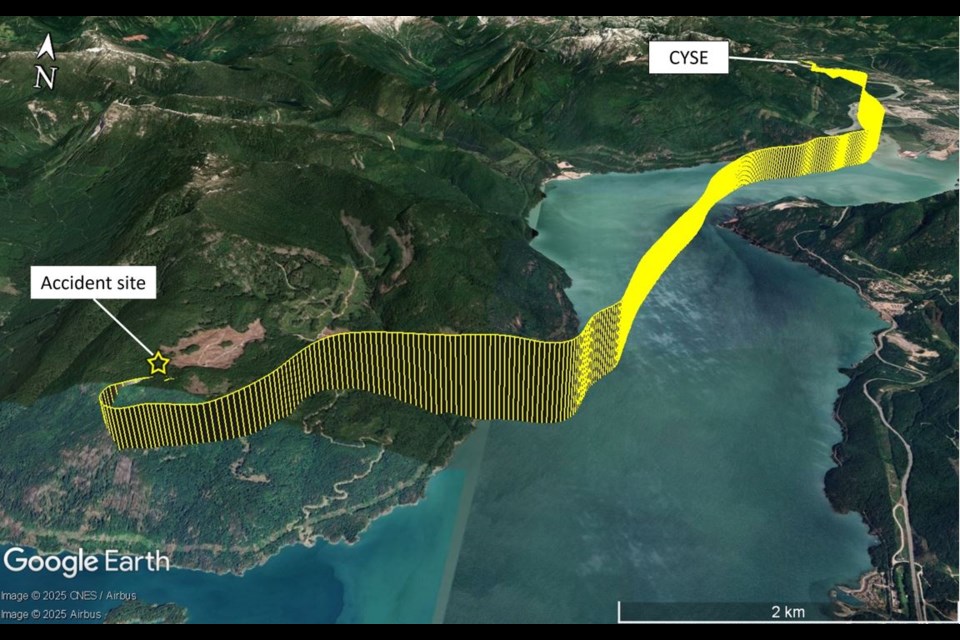A Transportation Safety Board of Canada (TSB) report released July 10 provides insights into a fatal plane crash that occurred on May 24, 2024, that took the lives of the pilot and passenger.
The crash of the privately registered amateur-built aircraft took place about 12.5 nautical miles south-southwest of Squamish Municipal Airport, on the west side of Howe Sound.
The TSB investigates crashes like this one to advance transportation safety, not to assign blame, the agency states.
Flight timeline
According to the report, the pilot was flying from Squamish Airport to Courtenay Airpark, a small public airfield located on the banks of the Courtenay River, with one passenger on board.
The flight was by Visual Flight Rules (VFR), meaning the pilot was operating the aircraft by observing the terrain out the window.
These flights are intended for sufficiently clear weather conditions that allow the pilot to see terrain and obstacles clearly.
The plane left Squamish Airport at about 5:08 p.m. that Friday, May 24, 2024, and then followed the approximate path of the Squamish River, the TSB safety investigation report states.
At 5:16 p.m., the aircraft, which had been following Howe Sound southbound, was now flying toward rising terrain, the report notes.
At approximately 5:20 p.m., the plane crashed into the heavily forested, mountainous, uneven terrain, killing both on board.
Possible spiral
The report states that right before the crash, the plane's flight path "was consistent with the characteristics of a spiral," which it defines as "a steep descending turn in which airspeed, rate of descent, and wing loading increase rapidly.”
Later, it notes that the plane's wreckage was consistent with there having been a spiral before impact.
Pilot experience, training and condition
The pilot had a private pilot's licence and had accumulated a total of approximately 310 hours flight time and approximately 230 hours of flight in the plane that crashed since his licence was issued in 2021.
The report states the pilot had five hours of instrument flight training experience—meaning learning to fly just by instruments, without visual cues from the outside environment—which is the minimum required to hold a private pilot licence.
The report also notes that in the Airplane Flying Handbook, the U.S. Federal Aviation Administration (FAA) states that pilots typically get into a spiral when they rely on "kinesthetic sensations rather than on the flight instruments."
According to information gathered by the TSB during the investigation, there was no indication that the pilot’s performance was affected by medical, physiological, or pathological factors.
The plane
The Murphy Rebel aircraft, described as a rugged aluminum kit aircraft on the company's website, was manufactured in 2000 and brought to Canada from the U.S. in 2017.
The engine of the plane was brought to the TSB’s facility in Richmond for examination.
While it was overdue for its annual maintenance inspection by 94 days, according to TSB's inspection of the aircraft engine and flight controls, there were no signs of pre-impact mechanical failure or system malfunction.
Weather
The TSB investigation was unable to determine what weather information the pilot had obtained before departure.
The report states that weather forecasts “indicated generally VFR conditions along the route of flight,” and the winds were calm; however, there were patchy clouds, some light rain and low ceilings.
"All reported ceiling heights near the [crash] location in the hours after the occurrence were lower than the elevation of the accident site, and search and rescue [aircraft] were unable to land in the vicinity of the site as a result,” the inspection report reads.
Search and rescue
At 5:21 p.m., the plane's emergency locator transmitter alerted the Canadian Mission Control Centre, which processes satellite-collected signals to provide distress alert notifications and data to SAR agencies, of the crash.
The TSB states that a cellular phone on board also had a crash-detection feature sent out a notification to the emergency contacts of the device owner.
"As a result, friends and family of the aircraft occupants became aware of the occurrence concurrently with search and rescue (SAR) services," the report reads.
SAR operations were ultimately called off when it was reported that the downed pilot and passenger had not survived the accident.
However, prior to this, the report states that a civilian aircraft flew through the search area, causing a pause in one SAR aircraft's rescue flight, and was ultimately asked to leave the area, which it did.
Key safety takeaways from investigation
The TSB offers the following lessons as a result of the investigation into this Squamish tragedy:
• Pilots are reminded that flying VFR in marginal weather conditions, such as low ceilings, is challenging, especially when flying in and around mountainous terrain. Pilots need to consider strategies to avoid adverse weather, as well as have plans should such weather be encountered.
• Pilots of aircraft not engaged in SAR operations are reminded to avoid SAR areas or exercise extreme caution whenever it is necessary to enter them.
• It is essential that pilots participate in radio communications with nearby aircraft for the purpose of avoiding collision, especially so in areas where SAR operations are taking place.
Read the full report on TSB's website.



